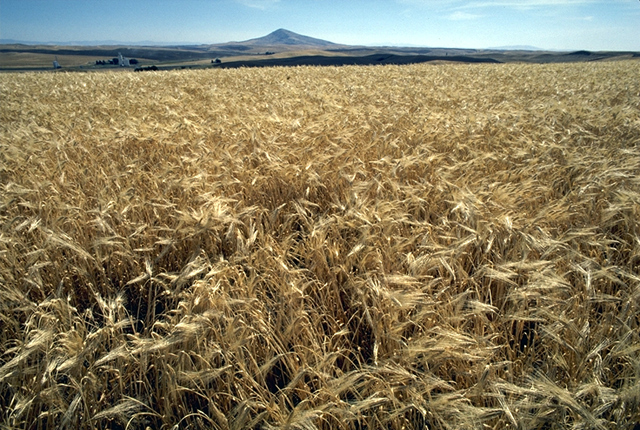 |
| A glowing, fluffy field of barley with some pretty, swoopy mountains in back. |
 |
| So these is barley plants then? |
Not to mention it's a diet drink, though I don't know where exactly, believed to help get rid of unwanted fat for you. It's also a laxative, but I don't know how popular it is for that feature. But, I hear (at least some of you) ask, warily eying the last sentence, what is mugicha?
To give you an actual definition, mugicha is a (caffeine-free) drink that's made with toasted barley and water (which means it's a tisane). In Japan, it's a thing to drink it in the summer, and ice is perfectly alright to add to it. Why drink it in summer? Its supposed to refresh those bogged down with the heat of summer temperatures. However, it's also a thing in Japan to drink mugicha warmed up in the winter. Sweetened or unsweetened are both acceptable as well, though I'm not sure if that goes for both hot and cold mugicha or just the cold or what.
 |
| Sure looks like pearl barley to me. |
He was right -- it tastes like Kashi, the puffed-gain cereal as located in the health food section. And, from my imperfect memory, I think it did sort of have a coffee type roasty-ness too. How do I know this? I made some (for the first time ever) this July. Here's a picture of it:
Want to make your own? There's lots of recipes out there, with lovely pictures on how to make it using pearl barley -- one roasts it via a skillet, no oil or anything, then simmers the result in water. La Fuji Mama's recipe has pictures showing the stages of toasty-ness that the barley goes through while it's in the skillet, as well as other helpful pictures (clicky). ( It was this site I used to make my aforementioned mugicha). La Fuji Mama also says there are several differences between un-hulled barley and pearl barley mugicha -- un-hulled barley mugicha isn't as sweet as the kind made with pearl barley and doesn't exactly have the same flavor.
But while you can make mugicha at home, there are commercial boxes of *huge* bags of it (each bag makes a pitcher), where all one does is put a bag into cold water (that's right -- cold water, a plus in hot weather), and wait for whatever length of time is stated in the box's directions. These bags use un-hulled roasted barley. If you don't want to spend any time at all making some, there's bottles of pre-brewed mugicha.
Now for a quick little health-scare PSA. There's acrylamide in mugicha (at least, the way the people studying mucha brewed it). This chemical may or may not cause cancer. Boo.
Oh, and one book said it's not barley that's used, it's wheat. And another said barley or rye. Type-o, or a deeper conspiracy? It might be a just type-o, as mugi can be used to mean, among other grains (rye, oats, barley), wheat -- though if you say it without explaining, people think you mean barley.
 |
| A pretty rendition of beef and barley soup. Just thought I'd put it here. Enjoy! |
References:
Sheesh, this is a long list! (Maybe I should start doing inline citations)
"Keith Michell's Practically Macrobiotic Cookbook"; Keith Michell; 2000
La Fuji Mama: Homemade Mugicha—Japanese Roasted Barley Tea
"Japanese Women Don't Get Old or Fat"; Naomi Moriyama, William Doyle; 2005
"Pretty Good Number One: An American Family Eats Tokyo"; Matthew Amster-Burton; 2013
"A Cook's Journey to Japan: Fish Tales and Rice Paddies 100 Homestyle Recipes from Japanese Kitchens" Sarah Feldner; 2012
"Kyotofu: Uniquely Delicious Japanese Desserts"; Nicole Bermensolo; 2015
"Lonely Planet Japan"; Lonely Planet, Chris Rowthorn, Andrew Bender, Laura Crawford, Trent Holden, Craig McLachlan, Rebecca Milner, Kate Morgan, Benedict Walker, Wendy Yanagihara; 2013
"The Macrobiotic Way: The Complete Macrobiotic Lifestyle Book"; Michio Kushi; 2004
"Five Hundred Fun Facts About Japan"; DIANE Publishing Company, Dorothy Perkins; 1994
"The Sober Kitchen: Recipes and Advice for a Lifetime of Sobriety"; Liz Scott; 2003
"Japanese Food and Cooking"; Stuart Griffin; 2011
"A Dictionary of Japanese Food: Ingredients & Culture"; Richard Hosking; 2014
"Handbook of Bioenergy Crops: A Complete Reference to Species, Development and Applications"; Nasir El Bassam; 2010
"The new beauty: an East-West guide to the natural beauty of body and soul"; 1996
"Berlitz: Japan Pocket Guide"; Berlitz; 2013
"Edible Medicinal And Non-Medicinal Plants: Volume 5, Fruits"; T. K. Lim; 2013
"Teach Yourself Japanese"; Prem Motwani, Noriko Nasukawa, Noriko Nasukawa; 1998
"The Complete Book of Japanese Cooking"; Elisabeth Lambert Ortiz, Mitsuko Endo; 2014
"Chemistry and Safety of Acrylamide in Food"; Mendel Friedman, Don Mottram (editors); 2005
